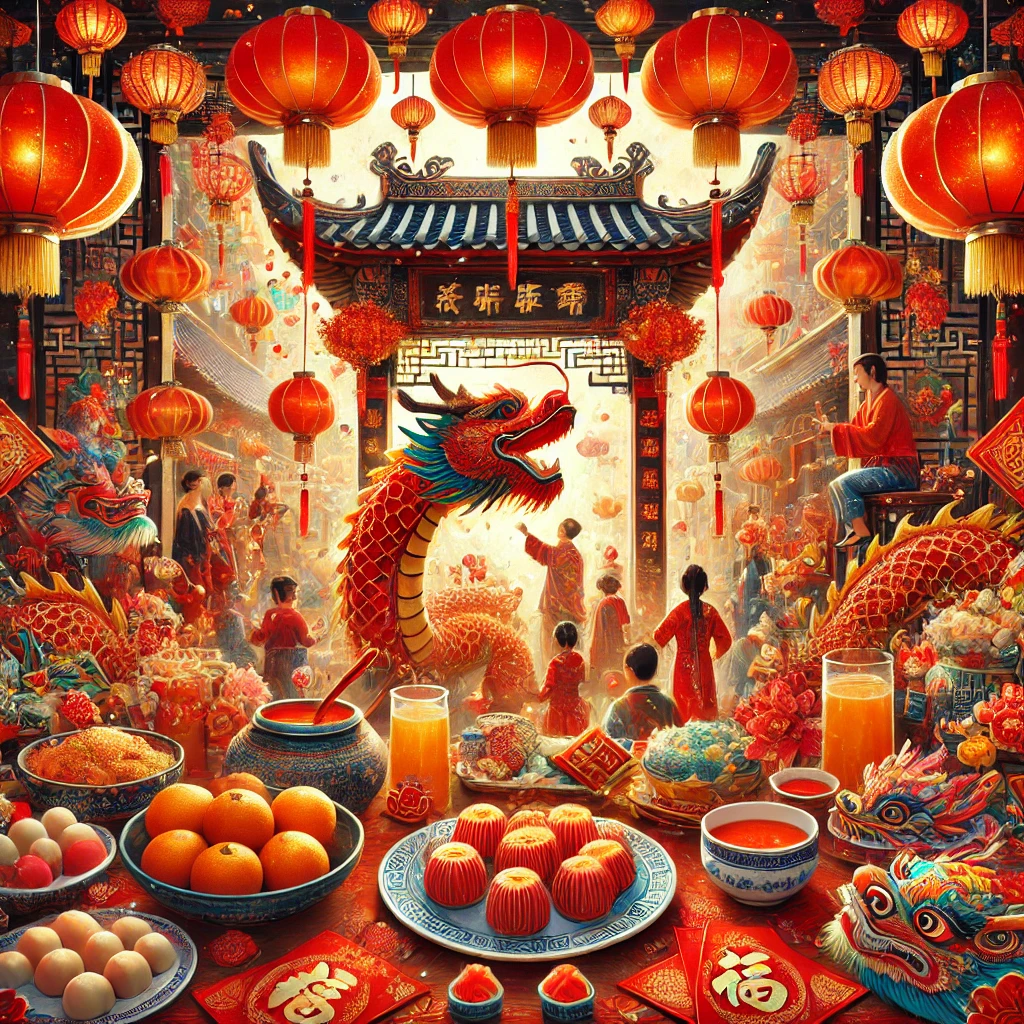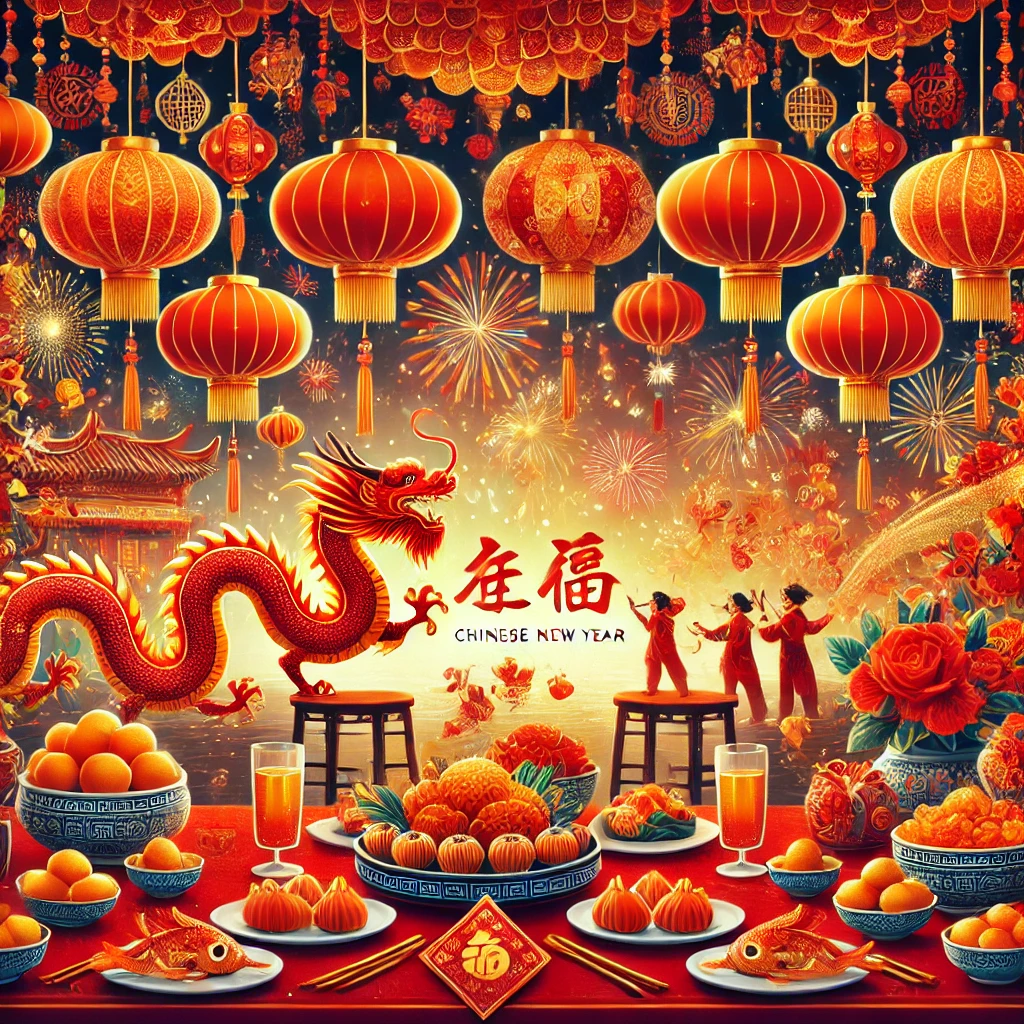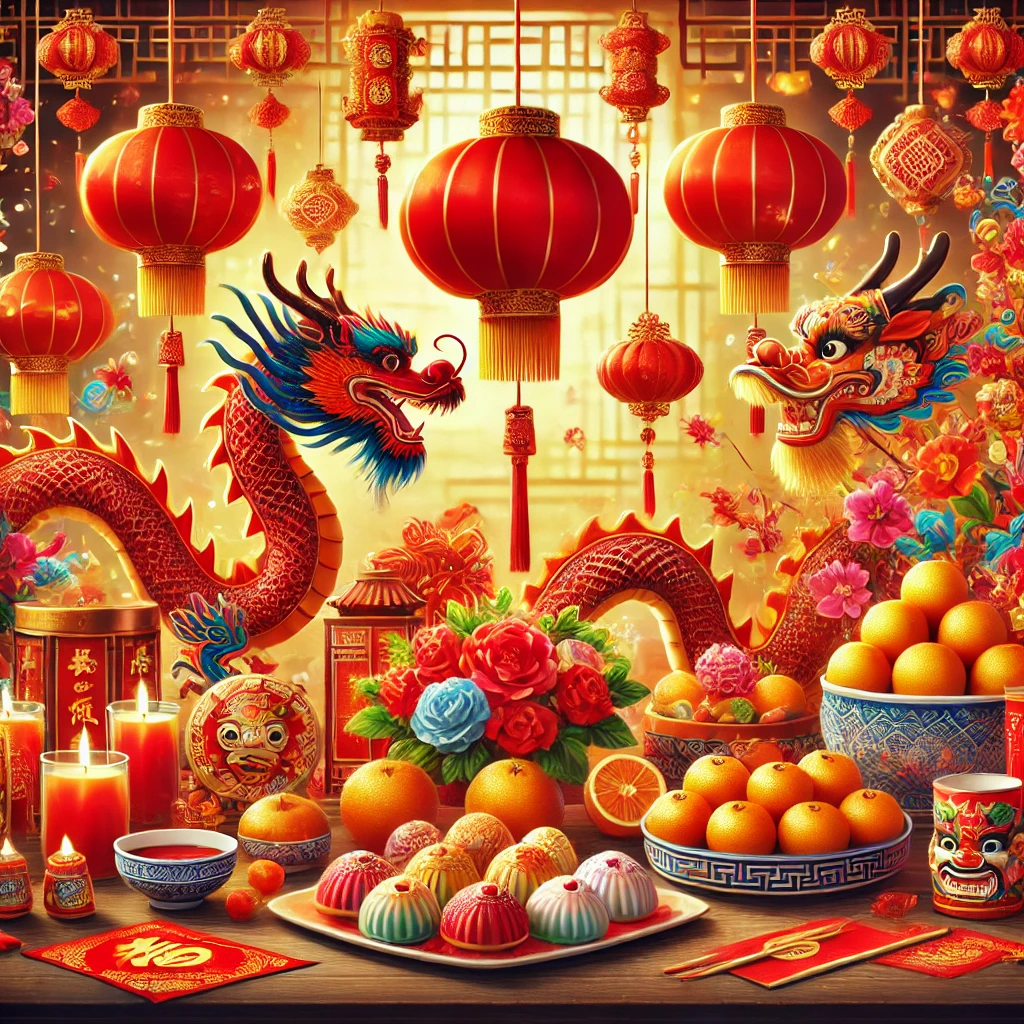Table of Contents
Introduction to Chinese New Year
Chinese New Year, widely recognized as the Spring Festival, is celebrated as the most important traditional holiday in China. This festival marks the beginning of the lunar calendar year, which varies each year based on the cycles of the moon. Typically falling between January 21 and February 20, the precise date of the celebration can fluctuate, creating a dynamic character for this cherished event. The lunar calendar plays a crucial role in determining the New Year date, emphasizing the significance of celestial movements in Chinese culture.
The significance of Chinese New Year goes beyond simple festivities; it embodies a cultural legacy that spans thousands of years. Celebrated by millions not only in China but also by Chinese communities worldwide, this festival represents a time for reunion, as families gather to honor their ancestors, express wishes for good fortune, and embrace the dawn of a new beginning. The customs and celebrations around Chinese New Year can vary significantly depending on regional traditions and cultural nuances. For instance, northern and southern parts of the country may showcase different foods, music, and festivities while still embracing a shared core of celebration.
In the lead-up to the New Year, preparations commence weeks in advance. Homes are meticulously cleaned to sweep away ill fortune and make way for incoming luck. Streets are adorned with vibrant decorations, predominantly in red, which symbolizes happiness and good fortune. The festival’s atmosphere is heightened through spectacular fireworks displays and lion dances, which are believed to ward off evil spirits. The rich tapestry of traditions associated with Chinese New Year demonstrates the deep-seated respect for history and family values that permeate Chinese society.

Historical Background of Chinese New Year
The historical origins of Chinese New Year can be traced back over 4,000 years, stemming from ancient agricultural societies that relied on seasonal changes to dictate their agricultural activities. Traditionally celebrated in late January or early February, this festival marks the beginning of the lunar new year and has deep connections to rituals intended to honor deities and ancestors. The customs associated with Chinese New Year have evolved significantly over centuries, influenced by various dynasties and historical occurrences.
One of the earliest beliefs associated with the New Year was the practice of welcoming the new year to ward off evil spirits and bring in good fortune. The legend of Nian, a fearsome beast that would emerge at the end of each lunar year, played a significant role in shaping early traditions. Families would use loud noises, bright lights, and the color red to scare away Nian, beliefs that continue to pervade modern celebrations. Thus, the incorporation of firecrackers, lion dances, and red decorations became integral to Chinese New Year festivities.
The impact of various dynasties through history has also played a crucial role in the transformation of the festival. The Han Dynasty is credited with establishing many of the customs still observed today, including the family reunion dinner, which highlights the importance of family unity. As the festival progressed through the Tang and Ming Dynasties, it expanded in richness and diversity, embracing various regional practices and cuisines, reflecting the vast cultural tapestry of the Chinese civilization.
Throughout its history, Chinese New Year has maintained its significance as a time for renewal and reflection. It serves not only as a celebration of the passing year but also as a bridge connecting generations, fostering a sense of cultural identity among Chinese communities around the world. The festival, deeply rooted in tradition yet ever-evolving, continues to play a pivotal role in the lives of millions, marking a moment of hope and new beginnings.
Key Traditions During the Festivities
Chinese New Year, known as Spring Festival, is steeped in rich traditions that play a crucial role in fostering family and community bonds. One of the most significant customs during this festive period is the family reunion dinner, typically held on New Year’s Eve. This gathering underscores the importance of family unity, where relatives from far and wide come together to share a meal, often featuring symbolic dishes such as fish for abundance and dumplings for wealth. The reunion dinner not only strengthens family ties but also serves as a moment of reflection on the past year while welcoming the new one with hope and optimism.
Another important tradition is the giving of red envelopes, or hongbao, which are filled with money. This practice is believed to bestow good luck and ward off evil spirits. The red color symbolizes happiness and good fortune, making the envelopes a cherished gift, particularly for children and unmarried adults. The act of giving and receiving hongbao reinforces the values of generosity and goodwill, which are essential during this festive time.
Prior to the New Year, thorough cleaning of the house is customary. This practice, known as “sweeping the dust,” is not merely an act of tidying up; it symbolizes the removal of bad luck and misfortune from the previous year. It is believed that cleaning the house before the New Year will pave the way for good fortune and prosperity in the coming year. Additionally, many people will adorn their homes with decorations featuring auspicious symbols and couplets, further enhancing the festive atmosphere.
These traditions during Chinese New Year reflect the deep-rooted cultural values of unity, respect, and hope for the future, transcending mere celebration to embody the spirit of togetherness and renewal within families and communities.
Symbols of Chinese New Year
Chinese New Year is deeply rooted in rich traditions and vibrant symbols that convey hopeful messages for the upcoming year. Among these, the color red stands out prominently. This hue symbolizes happiness, good fortune, and warding off evil spirits. During the celebrations, people don red clothing and decorate their homes with red lanterns and couplets, believing that these elements draw in good luck and positivity. The prevalence of red is an essential aspect of the Chinese New Year festivities, reinforcing the desire for a prosperous year.
The dragon also holds significant importance during this holiday. Revered as a symbol of strength, power, and good fortune, the dragon is often portrayed in vibrant parades. Dragon dances are a common feature, captivating audiences with their elaborate movements. The dance represents the community’s unity and the collective hope for peace and prosperity in the year to come. Similarly, the lion dance shares this celebratory spirit, embodying the beliefs in repelling evil and attracting good luck through its lively performance. Both dances contribute to the overall atmosphere of celebration and joy during the festival.
Food also plays a critical role in the symbolism of Chinese New Year. Specific dishes are prepared and consumed to ensure prosperity and happiness. Dumplings, shaped like ancient gold ingots, are a popular choice as they symbolize wealth and prosperity. Eating fish is another tradition; the word for fish (鱼, yú) sounds like the word for surplus, promoting the idea of abundance in the new year. These culinary traditions highlight the significance of sharing meals with family and friends, reinforcing bonds and fostering a spirit of gratitude and togetherness. Each symbol associated with Chinese New Year encapsulates aspirations for a year filled with good fortune and success, creating a joyous atmosphere that resonates throughout the celebrations.
Food and Culinary Delights
Food plays an integral role in the Chinese New Year celebrations, serving as a medium for cultural expression and a symbol of prosperity, happiness, and good fortune. Each dish is meticulously prepared with significance in mind, reflecting the hopes and aspirations for the forthcoming year. Traditional meals are often enjoyed during family gatherings, reinforcing the importance of familial bonds and the act of sharing good fortune.
Among the most notable dishes are dumplings, or ‘jiaozi,’ which are shaped like ancient Chinese silver or gold ingots, signifying wealth and prosperity. It is customary to prepare dumplings at midnight on New Year’s Eve, symbolizing the arrival of the new year and the opportunity for financial abundance. In some families, a coin may be hidden inside a dumpling, another layer to the festivity, with the lucky eater receiving an auspicious financial year ahead.
Fish (‘yú’) is another crucial dish during the celebrations. Typically served whole, it symbolizes surplus and wealth, as the Chinese word for fish sounds similar to the one for abundance. Families will often ensure that they do not finish the fish completely, thus ensuring that the surplus remains throughout the year. Other significant delicacies include ‘nian gao,’ a sticky rice cake that represents growth and progress, and ‘spring rolls,’ which symbolize wealth due to their resemblance to gold bars.
Furthermore, fruits such as oranges and tangerines are commonly exchanged as gifts, representing luck and prosperity. Food is not merely sustenance but a conduit of traditional values, bringing families together for cohesion, and strengthening communal ties. Through the central role that culinary delights play, the Chinese New Year festivities encapsulate the essence of renewal, hope, and joy for the future.
Modern Celebrations of Chinese New Year
Chinese New Year, also referred to as Lunar New Year, is a festival that has transformed over the years, particularly under the influence of globalization. In contemporary settings, the celebration has become a blend of traditional customs and modern practices, allowing communities worldwide to participate in festive activities that honor their heritage while embracing innovations.
In urban centers around the globe, vibrant parades mark the festive season, drawing large crowds eager to witness the spectacle. These parades are a fusion of traditional Chinese elements, such as dragon and lion dances, accompanied by modern entertainment forms including live music and colorful floats. Such events often showcase the rich cultural diversity present in cities today, where various communities come together to celebrate the significance of the occasion. In places like San Francisco, New York, and London, large-scale events not only highlight the importance of Chinese traditions but also foster intercultural understanding and camaraderie.
Community gatherings have become a focal point in celebrating Chinese New Year, serving as platforms for individuals to reconnect with their roots. Families and neighborhoods organize festive dinners featuring symbolic foods, which reflect customs passed down through generations. In addition to established traditions, contemporary practices have emerged, such as the incorporation of social media in sharing celebration experiences. Families now extend their reach through video calls and social media posts, allowing them to include distant relatives and friends in their joyous celebrations, regardless of geographical barriers.

Moreover, in various countries, local adaptations of Chinese New Year have arisen, illustrating the cultural significance and adaptability of the festival across different contexts. As global influences intermingle, modern celebrants often integrate local customs into their festivities, creating a unique fusion of practices. This melding of tradition with modernity not only preserves the essence of the festival but also enhances its relevance in a rapidly changing world.
Festivals and Events Across the Globe
Chinese New Year, also known as the Spring Festival, is celebrated in various countries and cultures beyond mainland China, each offering its unique interpretation and local customs. In Taiwan, the festivities are marked by family reunions, where generations gather to partake in traditional meals. The atmosphere is filled with vibrant decorations in red and gold, and the popular Lantern Festival concludes the celebrations, symbolizing unity and family harmony.
In Malaysia, the multicultural landscape incorporates a variety of traditions during the Chinese New Year. The celebrations, known locally as ‘Hari Raya Cina,’ blend Chinese customs with vibrant Malaysian festivities. The lion dance takes center stage, performed not only in Chinese neighborhoods but as part of public celebrations across the country. Furthermore, the tradition of visiting relatives and friends is widespread, emphasizing the importance of community and kinship.
Singapore serves as another vibrant venue for Chinese New Year celebrations, transforming its streets into a festival of lights and colors. The annual Chingay Parade showcases grand floats and performances that encompass the multicultural heritage of the nation. Furthermore, the iconic Chinatown district is adorned with stunning decorations and holds bustling street markets, allowing locals and tourists alike to immerse themselves in the festive spirit.
In Western countries, such as the United States, Chinese communities actively participate in parades and festivals that celebrate the Lunar New Year. Cities with significant Chinese populations, like San Francisco and New York, host grand events filled with dragon dances, fireworks, and traditional foods. These celebrations not only bring together the Chinese diaspora but also invite individuals from diverse backgrounds to appreciate and engage with this vibrant cultural heritage.
While the specifics of celebrations may vary from country to country, the essence of honoring ancestors, family, and cultural traditions remains a common thread that unites these festivities. Each event reflects the rich tapestry of Chinese New Year customs while incorporating local practices, fostering a sense of global camaraderie in celebrating this important occasion.
Myths and Legends Associated with Chinese New Year
Chinese New Year, also known as the Spring Festival, is steeped in a rich tapestry of myths and legends that enhance the celebratory spirit of the holiday. One of the most well-known myths revolves around the Nian monster, a fearsome creature said to emerge from the mountains at the end of each lunar year to terrorize villages. According to legend, Nian would feast on livestock, crops, and even people. This tale is significant as it explains various customs associated with the festival, particularly the practice of setting off firecrackers. The loud noise is believed to scare away the Nian, ensuring a peaceful new year.
In response to the threat posed by Nian, villagers discovered that the monster was particularly afraid of the color red, as well as loud noises. This led to the vibrant use of red decorations, the wearing of red clothing, and the use of firecrackers during the New Year celebrations, all of which aim to ward off evil spirits and bring good fortune. The Nian monster serves not only as an entertaining narrative but also as a reminder of the triumph of courage and resourcefulness over adversity.
Additionally, several deities are integral to the myths surrounding Chinese New Year. One such figure is the Kitchen God, revered for watching over families and reporting their behavior to the Jade Emperor. Before the New Year, it is customary to offer sacrifices to this deity to gain favor and ensure a good report. Another essential figure is the God of Wealth, who is believed to bring prosperity and good fortune. This has led to various rituals and celebrations aimed at attracting wealth, illustrating the deep connections between these legends and the wishes of the celebrants.
Overall, these myths and legends create a captivating narrative framework for Chinese New Year, linking the present-day celebrations to ancient customs and beliefs. They not only enhance the festival’s allure but also serve as educational tales that reinforce cultural values and community spirit during this important time of the year.
Conclusion: The Spirit of Chinese New Year
Chinese New Year embodies a rich tapestry of traditions and symbols that reflect the values and cultural identity of the Chinese people. At its core, this significant festival is a time for family reunions, where generations come together to honor their ancestors and celebrate the bonds that unite them. The emphasis on familial ties emphasizes the importance of community, love, and respect, which are fundamental aspects of Chinese society. Moreover, the rituals and customs observed during this period foster a deep sense of belonging and continuity, linking the past with the present.
Hope and renewal are pivotal themes of Chinese New Year. The onset of a new lunar year is viewed as an opportunity for fresh beginnings, where individuals set intentions for the year ahead while bidding farewell to negativity and misfortune. This symbolic cleansing is reflected in various customs, such as thorough cleaning of homes and the wearing of new clothes, both meant to invite auspicious energy and prosperity. Each décor and aspect of celebration, from lanterns to red envelopes, serves to channel positivity, abundance, and success into the lives of individuals and families alike.

Furthermore, the celebrations of Chinese New Year extend beyond individual families, resonating with larger themes of unity across cultures. Many traditions celebrated during this time are mirrored in various global customs, showcasing how the values of hope, renewal, and togetherness transcend geographical boundaries. It invites everyone, regardless of background, to reflect on their own cherished traditions, encouraging dialogue and understanding among diverse communities. As we embrace the spirit of Chinese New Year, we are reminded of the beauty found in our collective heritage and the importance of nurturing our connections with one another, ultimately fostering a message of peace and harmony.





